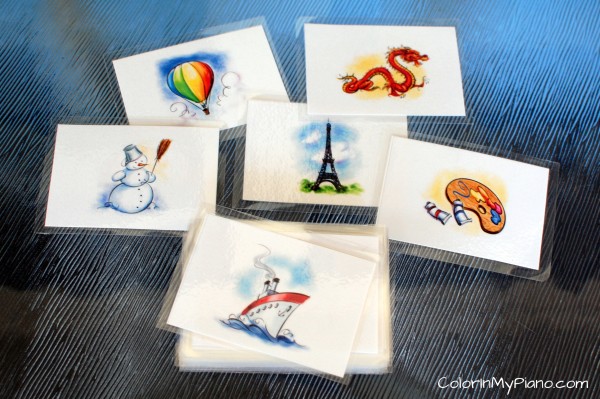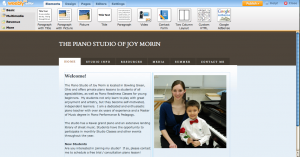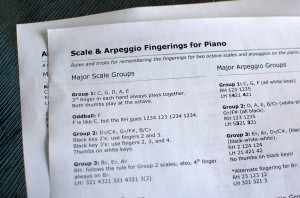Today I have a fun new printable to share!

Continue reading “Flashcard Prompts for Improvisation & Composition”
Today I have a fun new printable to share!

Continue reading “Flashcard Prompts for Improvisation & Composition”
 Have you ever visited a website and been completely overwhelmed with the amount of information, ads, links, and CLUTTER? Have also you ever visited a website and been impressed by the graphics and the ease with which you could find information? This post is going to offer some tips for organizing and effectively communicating value through your studio website.
Have you ever visited a website and been completely overwhelmed with the amount of information, ads, links, and CLUTTER? Have also you ever visited a website and been impressed by the graphics and the ease with which you could find information? This post is going to offer some tips for organizing and effectively communicating value through your studio website.
Studio Websites: A Necessity
Having a website is an important part of studio marketing. In a world where the internet is now the first place parents turn for business information rather than the phonebook, teachers need to maintain an online presence. The good news is, it’s a pretty affordable and easy way to market yourself as a piano teacher (see the resources section below) — definitely more affordable than an ad in the Yellow Pages! Continue reading “Studio Marketing: Communicating Value Through Your Website”
“I think music in itself is healing. It’s an explosive expression of humanity. It’s something we are all touched by. No matter what culture we’re from, everyone loves music.”
— Billy Joel
Every Wednesday brings Words of Wisdom here at the Color in my Piano blog in the form of a musical quote or joke, intended to bring inspiration or humor to the middle of your week. Have suggestions? Send an email off to admin[at]colorinmypiano.com.
 Every once in a while, I receive emails from readers wondering if their tuition rates are appropriate. Setting rates is a difficult topic to talk about, because for one thing, rate depend largely on the area where you live. For that reason, I can’t advise exact numbers — but with this article I hope to offer some guidelines and suggestions regarding this topic nevertheless.
Every once in a while, I receive emails from readers wondering if their tuition rates are appropriate. Setting rates is a difficult topic to talk about, because for one thing, rate depend largely on the area where you live. For that reason, I can’t advise exact numbers — but with this article I hope to offer some guidelines and suggestions regarding this topic nevertheless.
The Problem
I’m sure we’ve all experienced parents/students who are shopping for piano lessons by price. Let’s face it: many parents today (especially in America) shop for piano teachers based on price, even though they really should be “shopping” based on the teacher’s experience, education, professionalism, dedication, etc.. Parents shop by price because in their logic, little 6-year-old Suzie doesn’t need an expensive teacher unless they discover that she has a talent for piano and long-term interest. And they don’t know any better. Continue reading “Determining Tuition Rates for Piano Teaching”
Happy 4th of July! Today, America celebrates Independence Day. My parents have come over to visit us and see our new place, and we have a fun day of activities planned. 🙂
My husband and I are still exploring our new town and figuring out where things are. It’s kind of fun!! 🙂 Last week, I visited the local Goodwill store and found a bunch of Beanie Babies in really good condition for just 50 cents each. I’m such a sucker for thrift stores and consignment shops! I managed to find an animal for each letter of the musical alphabet except for “F”…I guess I need to find a frog, perhaps?! 🙂
You’ll notice I have more than one beanie animal for “C”. I simply couldn’t make up my mind.
Once I find that elusive frog for “F”, then I just need to get a floor staff! I have a few ideas for making a floor staff myself. We’ll see what happens during the upcoming weeks/months. I can’t wait to plan some games for my young beginner students using these furry friends. 🙂
Yikes, June is almost over already!! I’d better hurry up and post about these new (to me) links from around the blogosphere!
“One good thing about music – when it hits you, you feel no pain.”
— Bob Marley
Every Wednesday brings Words of Wisdom here at the Color in my Piano blog in the form of a musical quote or joke, intended to bring inspiration or humor to the middle of your week. Have suggestions? Send an email off to admin[at]colorinmypiano.com.
 It’s time to get another Forum Q&A going!! Let’s talk about business structure options for teaching studios. Despite having a music degree, I still know very, very little about setting up a business. I doesn’t seem right…I wish one of my college courses had covered this topic at some point. :/
It’s time to get another Forum Q&A going!! Let’s talk about business structure options for teaching studios. Despite having a music degree, I still know very, very little about setting up a business. I doesn’t seem right…I wish one of my college courses had covered this topic at some point. :/
Do you have a solo proprietorship, partnership, an LLC, or a corporation? What are the benefits of each option? Do you have a separate bank account set up to manage studio income and expenses? Do you hire an accountant or bookkeeping services to help with the accounts and taxes? What other business advice can you offer?
I hope you can help me out — and hopefully other readers will benefit too! Update: Here is my follow-up post.
 Lately, I’ve been getting a lot of requests for posts about how I’m building my studio since I moved to a new area. I have been reading a lot of books and articles about marketing lately, and I’ve been learning a lot! I’m happy to share what I’m learning, so I’m going to be posting a whole series of posts on studio marketing. The most important lesson I’ve learned is going to be addressed in the first post of the series: today’s post about creating value. Enjoy!
Lately, I’ve been getting a lot of requests for posts about how I’m building my studio since I moved to a new area. I have been reading a lot of books and articles about marketing lately, and I’ve been learning a lot! I’m happy to share what I’m learning, so I’m going to be posting a whole series of posts on studio marketing. The most important lesson I’ve learned is going to be addressed in the first post of the series: today’s post about creating value. Enjoy!
Marketing
Marketing, at a most basic definition, means promoting your business. While advertising and branding are indeed part of it, marketing is much more than that. Marketing is the combination of all your efforts to get people to remember your business, including having a creative website and make it easier to find. Marketing builds your brand, and your brand is what gets people to remember your business. And when people remember your business, they are more likely to buy from you. Continue reading “Studio Marketing: Creating Value”
 Some of you may remember the Scale & Arpeggio Fingering reference sheet I posted in December of 2010. About a month ago, a friendly reader made some very helpful suggestions for improvement, and so I spent quite a bit of time revising the printable. It’s called “Scale and Arpeggio Fingering for Piano (2 Octaves)” and you can find it on the Printables > Other Resources page.
Some of you may remember the Scale & Arpeggio Fingering reference sheet I posted in December of 2010. About a month ago, a friendly reader made some very helpful suggestions for improvement, and so I spent quite a bit of time revising the printable. It’s called “Scale and Arpeggio Fingering for Piano (2 Octaves)” and you can find it on the Printables > Other Resources page.
I originally created this printable with my intermediate/advanced students in mind who are working on 2- and 4- octave scales/arpeggios and have trouble keeping all their fingerings straight in their head once they start getting them under their fingers. It’s nice to have a guide tucked inside the front cover of a book to refer to now and then!
The document contains three pages:
Page 1: Rules and tricks for remembering scale and arpeggio fingerings (as shown on the right).
Page 2: A listing of the fingerings for each Major and Harmonic Minor scale/arpeggio (2-octave) for piano.
Page 3: A continuation of page 2.
Of course, there are a few different ways to finger scales and arpeggios, so I’m sorry if the fingerings listed in this printable do not correspond with the ones you prefer to teach your students. These are the ones I like to use, and I thought I’d share it with anyone who might happen to find it useful.
If anyone else finds typos or inconsistencies, please let me know! I did my best to proof-read the fingerings, but it is certainly possible that I still may have missed something!
 Scale and Arpeggio Fingerings (2 Octaves) Reference Sheet (86.0 KiB, 145,011 hits)
Scale and Arpeggio Fingerings (2 Octaves) Reference Sheet (86.0 KiB, 145,011 hits)
Today I’m proud to take you on the penny tour… 🙂
My husband and I feel so blessed to have found this adorable old house to rent. Continue reading “Tour of My Teaching Studio”
“When words fail, music speaks.”
— H.C. Anderson
Every Wednesday brings Words of Wisdom here at the Color in my Piano blog in the form of a musical quote or joke, intended to bring inspiration or humor to the middle of your week. Have suggestions? Send an email off to admin[at]colorinmypiano.com.
Your Cart is Empty